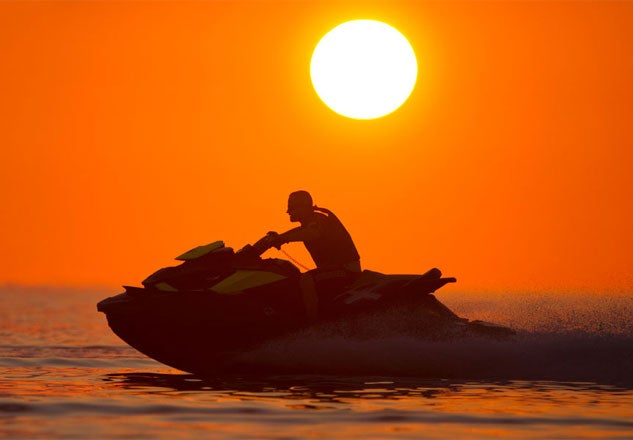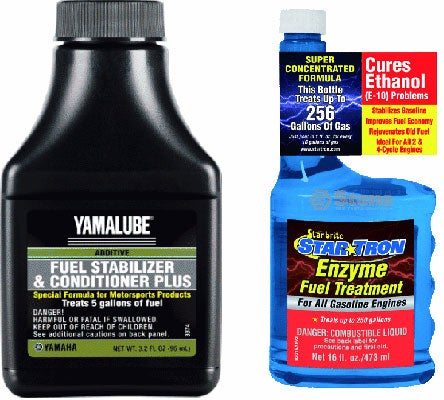How To Properly Stabilize PWC Fuel
Protect your engine from harmful ethanol
By now, you’ve probably heard the dire warnings about using ethanol-blended fuels in personal watercraft. In short, ethanol does some nasty things, not the least of which is that it mixes easily with water.
You may have also heard the term “phase separation.” That’s what happens when enough of that water accumulates (it only takes about 500 parts per million), bonds with the ethanol and then settles at the bottom of your fuel tank or gas can in a nasty layer. The process lowers the octane rating of your gasoline, meaning you’re not getting the number advertised at the pump. When it’s pumped to your engine, it can also wear injectors, stop the positive effects of lubricants, form gum and varnish, and maybe even destroy your engine.
 The sun is setting on the PWC riding season for many. Time to treat your fuel before putting your craft away for the winter.
The sun is setting on the PWC riding season for many. Time to treat your fuel before putting your craft away for the winter.In short, ethanol sucks but it’s not really going anywhere. E10 (10-percent ethanol) is almost a fixture in most U.S. service stations. As a result, most of us – or at least the majority who can’t find the few stations who stock ethanol-free gas – have to add something else to the mix to combat its effects. Enter ethanol-targeted fuel stabilizers and conditioners. Designed to stave off the effects of ethanol, they are formulated to be easily mixed with your fuel to keep your engines running properly and you out on the water having fun right where you belong. Sounds simple, right?
How To Extend Your PWC Riding Season Into The Fall and Beyond
Well, it is…and it isn’t. For whatever reason, some consumers still have questions, or could benefit from a little instruction. So, here are a few tips.
First, make sure you choose an ethanol-formulated stabilizer designed for gasoline engines. Don’t laugh; diesel versions exist, and some people – we’re not naming names here – may get confused. It doesn’t have to be a version branded by your PWC manufacturer of choice, although those work great. Any quality brand, like StaBil, West Marine, Star Tron or ValvTect, will do the trick.
 A variety of fuel treatment options are available. Please read the directions before adding any to your fuel tank.
A variety of fuel treatment options are available. Please read the directions before adding any to your fuel tank.Once you’ve selected a stabilizer, don’t just dump it in. Read the directions. You’ll want to add the appropriate amount of stabilizer for the amount of gas in your tank or gas cans. Brands vary, so know what you’re doing to make sure you don’t cause new problems while trying to prevent one. Ideally, add the stabilizer first, before pumping in the fuel. This will allow the stabilizer to thoroughly mix with the gasoline as intended.
If you’re getting ready to store your craft for winter – and that’s a lot of you this time of year – add the final dose of stabilizer before you pull the craft out. Take it for one last, brief ride or just run the engine on a flush hose for several minutes to allow the stabilized fuel to make its way through the entire fuel system. This will provide a little peace of mind, knowing you’ve not only protected your fuel but also the hoses and filters that sit between your fuel tank and engine.
Six Commonly Overlooked Winterizing Tips for PWC
Should you be using fuel stabilizer in every tank of fuel that passes through your engine? Yes, unless you’re certain that fuel is ethanol-free. No one likes to hear that, but it’s the reality of today’s fuel supply. And relatively speaking, it’s cheap protection. Depending on the brand, most fuel treatments break down to no more than 25 cents per gallon. In fact, many are as little as 7 cents per gallon.
And as the saying goes, an ounce of protection…is worth a pound of cure.
Get PersonalWatercraft.com in your Inbox!
Like PersonalWatercraft.com on Facebook
Comments
Most Popular

2025 Yamaha JetBlaster PRO 2-Up Review

2024 Kawasaki Jet Ski STX 160X Review

Remembering the Sea-Doo XP

Whatever Happened to the Wetbike?

2025 Yamaha JetBlaster Review













 Your Privacy Choices
Your Privacy Choices